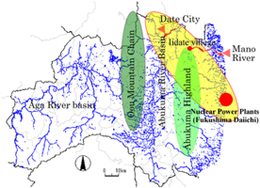Research Abstract
福島を含む東日本の淡水魚の放射性セシウム汚染の概況
Overview of active cesium contamination of freshwater fish in Fukushima and Eastern Japan
2013年4月29日 Scientific Reports 3 : 1742 doi: 10.1038/srep01742

本論文では、2011年に水産庁が発表したデータに基づき、福島を含む東日本の淡水魚の放射性セシウム137(Cs134を含む準Cs137)汚染の概況に着目した。淡水魚の汚染度は福島第一原子力発電所の北側および西側の地域で高くなっていた。例えば、同原発の北西20~40 kmを流れる真野川では、アユ(Plecoglossus altivelis)の放射性セシウム(準Cs137)汚染の平均値が2,657 Bq/kgであった。同原発から70~150 km西に位置する会津地方の阿賀野川流域では生態濃縮が認められ、肉食性であるサケ類の放射性セシウム(準Cs137)汚染は草食性のアユの約2倍であった。アユの放射性セシウム(準Cs137)汚染は東日本一帯に認められ、同原発から南西に400 km離れた静岡県でも一定の汚染が確認された。
水野 敏明1 & 久保 英也1
- 滋賀大学経済学部附属リスク研究センター
This paper focuses on an overview of radioactive cesium 137 (quasi-Cs137 included Cs134) contamination of freshwater fish in Fukushima and eastern Japan based on the data published by the Fisheries Agency of the Japanese Government in 2011. In the area north and west of the Fukushima Nuclear plant, freshwater fish have been highly contaminated. For example, the mean of active cesium (quasi-Cs137) contamination of Ayu (Plecoglossus altivelis) is 2,657 Bq/kg at Mano River, 20–40 km north-west from the plant. Bioaccumulation is observed in the Agano river basin in Aizu sub-region, 70–150 km west from the plant. The active cesium (quasi-Cs137) contamination of carnivorous Salmondae is around 2 times higher than herbivorous Ayu. The extent of active cesium (quasi-Cs137) contamination of Ayu is observed in the entire eastern Japan. The some level of the contamination is recognized even in Shizuoka prefecture, 400 km south-west from the plant.

